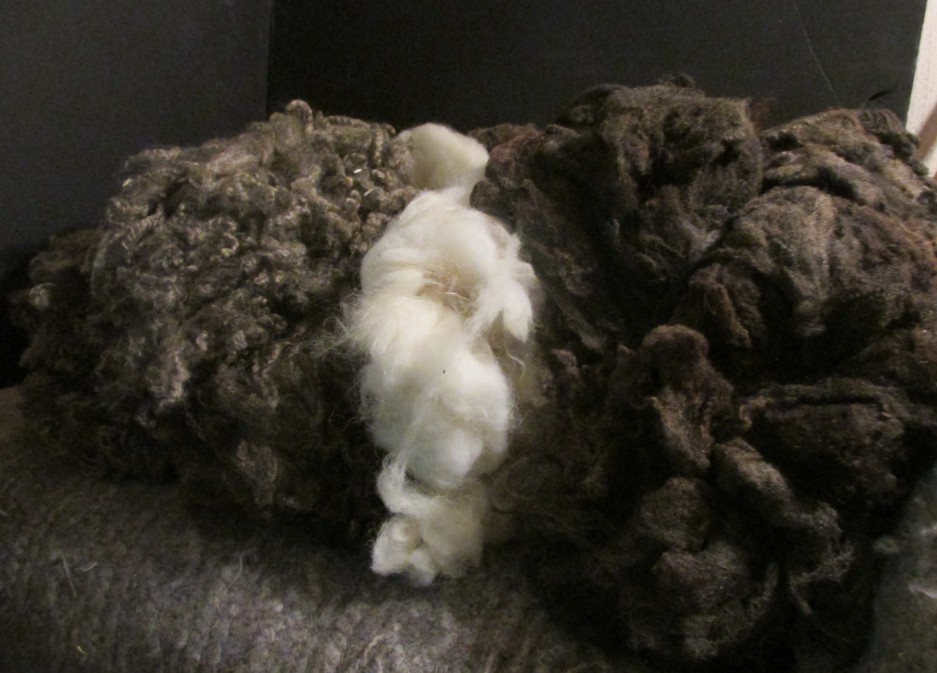Hello
FIBERuary Day 27 SKIRTING FLEECES
Skirting Fleece
“Skirting” is the traditional term for removing less desirable/ clearly unusable parts of a sheep fleece. When a fleece is laid out- cut side down- it looks something like this:
(in this sketch, the head end of the fleece is facing down). You’ll see that the outside edges of the fleece, all the way around, are the edges to be removed. (Think of a laid out skirt, with the hem chopped off.)
It’s helpful to lay the fleece out on a skirting table. Ours is about 4’ by 8’, a wooden frame around welded wire that’s set on sawhorses. The holes in the wire let some small bits fall through.
The amount of skirting to be done on any particular fleece can vary tremendously: all the way from none to virtually the entire fleece.
For me, the two things I’m skirting is fiber that is structurally unsound or contaminated by vegetation. Structurally unsound fleece can be:
- Fleece from the belly or legs (often a very different quality).
- Fleece with kemp (hair not wool) fibers- unless from a fleece that should have kemp.
- Fleece so weathered that all oil is gone. This fleece is usually found around the edges and (particularly in luster fleece) along the backbone.
- Parts of fleece that are cotted (clumped together)
- Fleece with a break (usually caused by stress, when the wool growth has been retarded)
- Fleece contaminated with manure and so weathered or colored.
- “Second cuts” or short bits where the shearer has sheared some fleece twice.
Most vegetal contamination is caused by hay or by weeds. Sheep are gregarious creatures, and love to chew while turning their head over the back of the sheep next to them. (My tallest sheep almost always have less back hay than the shorter ones.) They love to pull out great bunches of hay, dropping the uneaten portions. This is why most sheep feeders have small openings, forcing the sheep to take smaller bites. Sheep will also dribble hay over their own and their neighbors’ neck wool. Weeds can be of many species. We’re renovating old pasture and my two biggest problems come from burdock and thistles…sometimes I don’t get to removing them before the sheep find them. Burdocks aren’t too bad to get out- as long as they’re removed right after they attach. I once had some sheep get into beggars’ ticks- most of that fleece had to be tossed.
So from a shepherd’s perspective, how do you keep the fleeces clean? There are lots of strategies:
- Most time consuming, expensive and effective are sheep coats. These need to be kept clean (washed and dried after a bout of hot, wet weather- and other times. Lots of labor- but the value of your fleece is doubled- or tripled.
- Pay attention to your pastures. Always check them and remove weeds before turning the sheep into a new section.
- In winter with snow, ground feed your sheep on clean snow each day. When you do this, you break the bale into flakes and lay each flake out about 3 feet from any other. This reduces hay from one dropping into the fleece of a neighboring sheep.
- We’re trying a new experiment this year, shearing in the fall instead of the spring. This means that we’re shearing fleece that’s been grazing and not eating hay for five or six months. The hay falling onto shorter fleece seems to stick less- and some likely washes out over the summer. The couple we experimented with worked well- we’ll have to see what the whole group look like in October.
The photos are of a Romney fleece with six months growth which was shorn in the fall. The fleece is a bit jumbled- but the first picture shows about one third of the fleece, with the two small piles on the right being the fleece I’ve skirted out.

The next photo is a close up of some of the wool so you can see the staple.

From a spinner’s perspective, a lot depends on how bad the fleece is and how much you like it. One of the frustrations is that the finest fleece around the neck is generally in the worst shape, as shown on the two diagrams below. 
When I skirt I actually sort into three bags: Prime, Seconds, and Skirtings. I’ve learned that I can often use the seconds- after washing and dyeing they can surprise me. I’m still looking for skirting uses. It composts very slowly, makes lousy mulch. I’ve had people use it for insulation in a double wall (unwashed….not sure what it attracts). Someone tried to use it as the first layer on a green (ie, planted) roof. Our dogs have bags of it to sleep on during cold winters….but I just replace the wool if it gets soaked with urine or throw-up.
I do weigh and make notes about each fleece, and I use those notes when breeding and when culling.
When you buy a fleece it should be clean! You still should lay it out and look at it whole. Are the different sections of fleece similar in staple length and softness? If not and you want to make one project from that whole fleece, you’ll need to take care to evenly blend the different kinds of fiber. Lots of times I just use the different types of fleece in different ways.
Hope this helps you approach a fleece- buying one raw (in the grease) is a great way to start. Fun- and it smells good.
Jill Horton-Lyons
Winterberry Farm
